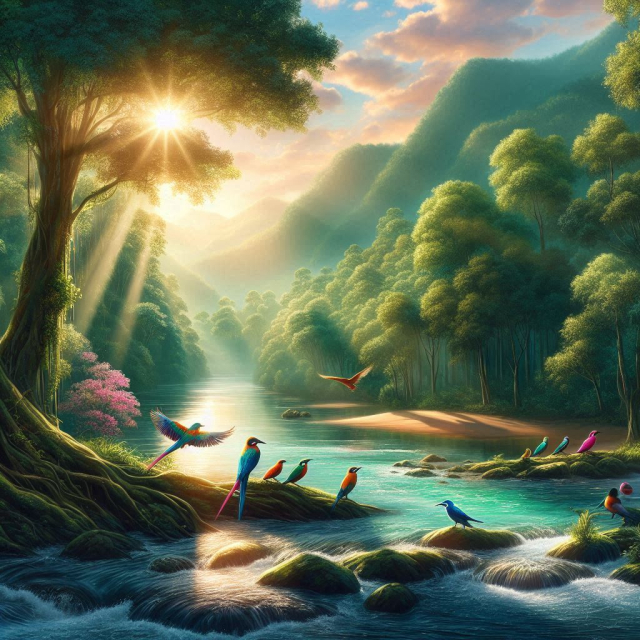Rivers have been fundamental to the development of life and human civilization since time immemorial. These freshwater streams not only shape Earth's landscapes, but also play a vital role in ecosystems, agriculture, industry and culture. In this article, we will explore the importance of rivers, their characteristics, the benefits they provide, the problems they face and the measures being taken to protect them.
The Importance of Rivers.
Fresh Water Fountain.
Rivers are a crucial source of fresh water, which is essential for life. They provide water for drinking, cooking, cleaning and irrigating crops. In many parts of the world, rivers are the main source of drinking water for millions of people.
Ecosystems and Biodiversity.
Rivers are home to a wide variety of life. From fish and amphibians to birds and mammals, river ecosystems are rich in biodiversity. Riparian zones, where rivers interact with the land, are particularly rich in species and play a crucial role in protecting fauna and flora.
Agriculture and Irrigation.
Agriculture has historically depended on rivers for irrigation. Ancient irrigation systems in civilizations such as Mesopotamia, Egypt, and the Indus Valley were made possible by the Tigris, Euphrates, Nile, and Indus rivers, respectively. Even today, intensive agriculture relies heavily on river water.
Hydroelectric power.
Rivers are also an important source of energy. Hydroelectric plants generate electricity by taking advantage of the power of running water. This type of energy is renewable and produces fewer greenhouse gas emissions compared to fossil fuels.
Transport and Commerce.
Historically, rivers have been vital routes for transportation and trade. In many regions, rivers continue to be used for transporting goods, especially in areas where land infrastructure is limited.
Culture and Recreation.
Rivers have a profound cultural impact. They have been inspiration for music, literature and art. Additionally, rivers provide opportunities for recreational activities such as fishing, boating, kayaking and rafting, contributing to well-being and tourism.
Characteristics of the Rivers.
Formation and Water Cycle.
Rivers are formed from water sources such as springs, glaciers and rainfall. The water cycle begins when surface water evaporates, condenses in clouds, and falls back to earth as precipitation. This water flows downward by gravity, forming streams and rivers that eventually flow into lakes, seas or oceans.
Watersheds.
A watershed is the area of land where all rain and snow water drains into a specific river. Watersheds can range in size from small areas to vast regions spanning multiple countries. The Amazon River basin, for example, is the largest in the world, covering approximately 7 million square kilometers.
Types of Rivers.
Rivers can be classified in several ways, including:
Perennial Rivers: They flow all year round.
- Seasonal Rivers: They flow only during certain times of the year, usually in rainy seasons.
- Ephemeral Rivers: Flow only after significant rainfall.
Zones of a River.
A river generally has three zones:
- Headwater Zone: Where the river originates. Here, the water is usually clear and cold, flowing quickly.
- Middle Zone: Where the river widens and its speed decreases. Here, the water may be cloudier due to sedimentation.
- Mouth Zone: Where the river meets another body of water. In this area, the river can form deltas, areas rich in nutrients and biodiversity.
Problems Facing Rivers.
Pollution.
One of the biggest problems facing rivers today is pollution. Industrial, agricultural and urban waste is dumped into rivers, affecting water quality and the health of aquatic ecosystems. Pollution can cause algae blooms, decreased oxygen in the water, and the death of fish and other life forms.
Climate change.
Climate change is affecting precipitation patterns and river flows. In some regions, this can result in droughts, reducing water availability. In others, it can increase the frequency and intensity of flooding, causing damage to communities and infrastructure.
Deforestation and Erosion.
Deforestation and inappropriate land use can increase soil erosion, which in turn affects sedimentation in rivers. Excessive sedimentation can alter the flow of a river, affect water quality and destroy aquatic habitats.
Construction of Dams.
While dams are essential for hydroelectric power generation and water storage, they can also have negative impacts. Dams can alter the natural flow of rivers, affect migratory species and change downstream ecosystems.
Protection and Conservation of Rivers.
Legislation and Policies.
Protecting rivers requires strong legislation and effective policies. Many countries have implemented laws to protect their water bodies, set pollution limits, and promote sustainable practices. Enforcement of these laws is crucial to ensuring the long-term health of rivers.
River Restoration.
River restoration is an increasingly common practice. It involves activities such as riverbank reforestation, the removal of artificial barriers and the reintroduction of native species. These efforts can help restore river ecosystems and improve water quality.
Sustainable Use of Water.
Sustainable water management is essential for river conservation. This includes practices such as precision agriculture, which minimizes water use and reduces nutrient runoff, and wastewater treatment, which ensures that water returned to rivers is clean.
Education and Awareness.
Education and public awareness are essential for the protection of rivers. Educational programs can teach communities about the importance of rivers and how they can contribute to their conservation. Additionally, awareness campaigns can mobilize people to participate in river cleanup and restoration activities.
Rivers are essential for life on Earth. They provide water, sustain ecosystems, support agriculture, generate energy, facilitate transportation and enrich our cultures. However, they face numerous challenges due to human activity and climate change.
The protection and conservation of rivers requires a global and coordinated effort. It is essential that we adopt sustainable practices, implement effective policies and educate future generations about the importance of these vital resources. Only through collective action and commitment can we ensure that rivers continue to flow and provide benefits to humanity and the environment for many years to come.
